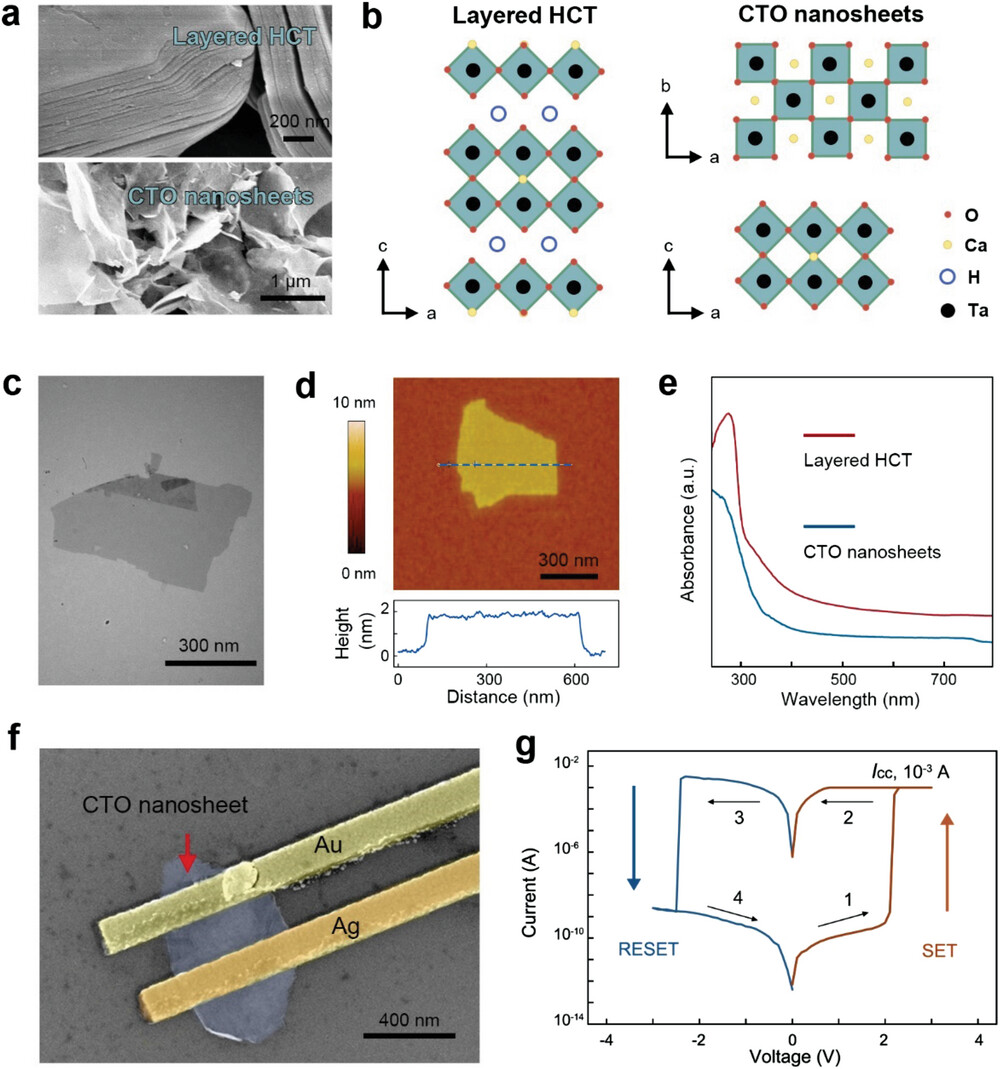| Nov 08, 2023 | |
2D Perovskite memristors pave way for neuromorphic AI with experience-based learning |
|
| (Nanowerk Spotlight) Memristors are electrical components that can alter their resistance based on the history of voltages applied to them. This gives them a type of memory analogous to the synaptic connections between neurons in the brain. Like biological synapses, memristors can be modulated to strengthen or weaken over time. This synaptic plasticity is thought to be the cellular mechanism behind learning and memory. | |
| Most previous memristor research has focused on data storage rather than mimicking the experience-based learning that occurs in biological brains. The human brain strengthens memories much faster when multiple senses are engaged, modulated by neurotransmitters like dopamine. To better approximate these capabilities, researchers in China set out to develop a memristor that could mimic experience-dependent synaptic plasticity. | |
| In this work, scientists fabricated memristors from atomically thin sheets of the perovskite CaTa2O7 (CTO). Applying different voltages switches the devices reversibly between high and low resistance states by driving silver ions through the CTO. Critically, illuminating the devices with UV light enhances this resistive switching effect. | |
| The team reported their findings in Advanced Functional Materials ("Neurotransmitter-Mediated Plasticity in 2D Perovskite Memristor for Reinforcement Learning"). | |
 |
|
| a) SEM images of layered HCT and CTO nanosheets. b) Schematic crystal structure of layered HCT and CTO nanosheets. c) TEM image of the as-prepared CTO nanosheets. d) AFM image and the corresponding height profile of the CTO nanosheet. e) UV–vis absorption spectrum of the layered HCT and CTO nanosheets. f) Top-viewed SEM image of the as-made CTO device. g) Representative switching in the I–V curve with the current compliance (Icc) of 10−3 A. (Reprinted with permission by Wiley-VCH Verlag) | |
| The team showed this photo-assisted switching mimics key features of biological synaptic plasticity. Brief voltage pulses induced short-term potentiation of device conductance, while sustained pulses led to long-term potentiation analogous to memory formation. The UV light controlled the degree of potentiation, emulating how neurotransmitters strengthen synaptic connections. | |
| Importantly, the perovskite memristors retained their programmed resistances for over 10,000 seconds at room temperature. They also performed stably even when heated to 77 °C, attributable to CTO’s crystalline structure. | |
| Leveraging these synaptic mimicking abilities, the researchers configured a simple neural network and used the memristors to process handwritten digits. Introducing the light-mediated synaptic strengthening during training gave a 36% boost in recognition accuracy compared to memristors without UV illumination. | |
| This demonstration of ‘reinforcement learning’ at the device level is a key step toward neuromorphic chips that could autonomously learn and adapt like biological brains. Current AI relies on separate training and implementation phases, whereas experience-based learning allows continuous optimization of performance. | |
| Neuromorphic computing with adaptive memristor synapses could therefore lead to more capable and energy-efficient AI for tasks like pattern recognition and decision making. Self-learning is also crucial for intelligent robots to interact flexibly with real-world environments. | |
| The researchers highlight this is only an initial proof-of-concept of using 2D perovskites for synaptic mimicking. Considerable research is still needed to integrate many memristors into full working neuromorphic processors. | |
| Nonetheless, this work provides a promising materials platform to develop memristors with the sophisticated plasticity required for artificial general intelligence. Looking forward, tailoring the properties of 2D perovskites could produce memristors tuned to different specific learning rules. | |
| The CTO memristors showed stable long-term potentiation and depression of resistance in response to voltage pulses, mimicking synaptic strengthening. Critically, illumination with UV light enabled modulation of the degree of potentiation, emulating the role of neurotransmitters in reinforcement learning. Furthermore, the devices exhibited robust switching stability over 10,000s even at elevated temperatures. | |
| By incorporating these memristors into a simple neural network, the researchers achieved a significant improvement in handwriting recognition accuracy. This demonstrates the potential of using 2D perovskite memristors for reinforcement learning in neuromorphic processors. | |
| Considering the combined capabilities of memory storage, adaptive resistance modulation, and direct information processing, this work offers opportunities to develop intelligent robots capable of experience-based learning. The fully integrated sensing, processing, and memorization in a single memristive component could enable more autonomous and energy-efficient neurocomputing. | |
| The authors point out that further research is needed to construct large-scale neuromorphic systems, but this study provides a promising materials platform for artificial general intelligence with sophisticated, lifelike learning abilities. | |
 By
Michael
Berger
– Michael is author of three books by the Royal Society of Chemistry:
Nano-Society: Pushing the Boundaries of Technology,
Nanotechnology: The Future is Tiny, and
Nanoengineering: The Skills and Tools Making Technology Invisible
Copyright ©
Nanowerk LLC
By
Michael
Berger
– Michael is author of three books by the Royal Society of Chemistry:
Nano-Society: Pushing the Boundaries of Technology,
Nanotechnology: The Future is Tiny, and
Nanoengineering: The Skills and Tools Making Technology Invisible
Copyright ©
Nanowerk LLC
|
|
|
Become a Spotlight guest author! Join our large and growing group of guest contributors. Have you just published a scientific paper or have other exciting developments to share with the nanotechnology community? Here is how to publish on nanowerk.com. |
|
